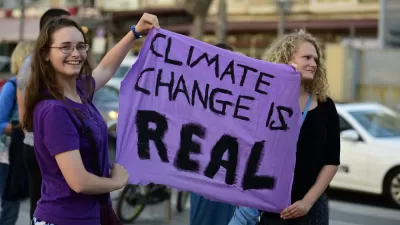The Prince George's County draft Climate Action Plan includes ambitious goals and timetables, but falls short of recommended targets for emissions reductions in the transportation sector.

In an opinion piece published in Greater Greater Washington, Bill Pugh reacts to Prince George's County's draft Climate Action Plan (CAP), calling for "a plan that helps create walkable, inclusive transit-oriented development that can drive economic prosperity and sustainable, equitable communities."
Pugh writes that while the CAP sets actionable goals and timelines and clearly illustrates the real impact of climate change, it does not go far enough to achieve the county's emissions reductions target. According to Pugh, the plan should take stronger action on transportation emissions, which make up the largest source of the county's greenhouse gas pollution.
National energy experts at Rocky Mountain Institute show that to adequately reduce climate pollution from transportation, the United States must make sure a quarter of cars on the road are clean electric vehicles by 2030 and also cut the amount Americans need to drive by 20%.In contrast, Prince George’s climate plan falls short on both accounts: it calls for only 15% of cars, SUVs and pickups in the county to be electric by 2030 and seeks a meager 3.6% reduction in how much families and workers in the County have to drive on a daily basis.
However, the plan does propose new growth management policies and encourages infill development and affordable housing production, prioritizing development in dense, transit-accessible areas.
Pugh also recommends that the plan, which will be finalized in early 2022, include advocacy for regional efforts to build more affordable, transit-oriented housing developments.
FULL STORY: Prince George’s climate plan proposes swift action, but how does it address transportation and land use?

Alabama: Trump Terminates Settlements for Black Communities Harmed By Raw Sewage
Trump deemed the landmark civil rights agreement “illegal DEI and environmental justice policy.”

Study: Maui’s Plan to Convert Vacation Rentals to Long-Term Housing Could Cause Nearly $1 Billion Economic Loss
The plan would reduce visitor accommodation by 25% resulting in 1,900 jobs lost.

Why Should We Subsidize Public Transportation?
Many public transit agencies face financial stress due to rising costs, declining fare revenue, and declining subsidies. Transit advocates must provide a strong business case for increasing public transit funding.

Paris Bike Boom Leads to Steep Drop in Air Pollution
The French city’s air quality has improved dramatically in the past 20 years, coinciding with a growth in cycling.

Why Housing Costs More to Build in California Than in Texas
Hard costs like labor and materials combined with ‘soft’ costs such as permitting make building in the San Francisco Bay Area almost three times as costly as in Texas cities.

San Diego County Sees a Rise in Urban Coyotes
San Diego County experiences a rise in urban coyotes, as sightings become prevalent throughout its urban neighbourhoods and surrounding areas.
Urban Design for Planners 1: Software Tools
This six-course series explores essential urban design concepts using open source software and equips planners with the tools they need to participate fully in the urban design process.
Planning for Universal Design
Learn the tools for implementing Universal Design in planning regulations.
Smith Gee Studio
Alamo Area Metropolitan Planning Organization
City of Santa Clarita
Institute for Housing and Urban Development Studies (IHS)
City of Grandview
Harvard GSD Executive Education
Toledo-Lucas County Plan Commissions
Salt Lake City
NYU Wagner Graduate School of Public Service





























